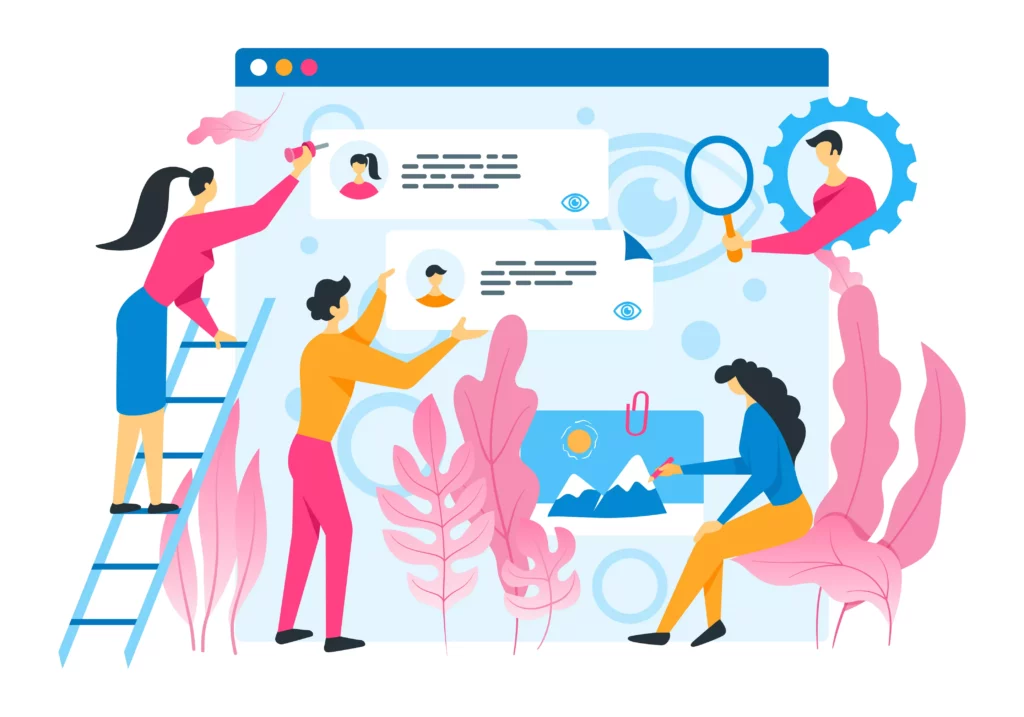When thinking about how to develop an employee training program, many things come into play. You need to consider where people are in the world, your budget, what needs to be covered and the technology available to you. On top of all of that, you also need to consider which style of training, synchronous vs. asynchronous training, is right for you.
Asynchronous training has no real-life interaction and can be done at any time, allowing the learning to be self-paced. Until recent years, this style of training was very much in favor, with asynchronous training being worth $20.85 billion in the U.S. in 2016. However, this figure has dropped dramatically to $15.86 billion in 2021. Does this mean that synchronous training, a type of training that is instructor-led, whereby learners and instructors are engaging in real-time, is back in fashion?
Constant and proper employee training, whether synchronous or asynchronous training, is essential for business success. It creates engaged employees, which in turn improves employee retention rates. In this article, we will help you to nail your employee training program. We will explore synchronous vs. asynchronous training, and dive into the pros and cons of both.
Synchronous Training
What is synchronous training?
The synchronous training definition is derived from the word ‘in-sync’, which means two people coming together at the same time. Essentially, synchronous training includes any form of workplace learning that takes place in real time, where the instructors and learners can engage actively with each other.

Although previously done mainly in-person, modern technology means that synchronous training can be done with both in-person and virtual teams. Literally, all it requires is live, real-time interactions between the person teaching and those learning, whether on a computer screen or in a meeting room.
Examples of synchronous training include instructor-led demonstrations and assessments, in-person role plays, one-to-one personal tutoring, break-our rooms, instant messaging channels, live-streamed webinars and lectures, and online webinars that include question and answering sessions.
Pros of Synchronous Training
We can’t recommend adding synchronous training to your employee training program enough. There are many advantages of synchronous training, such as:
- It’s suitable for all types of teams
With modern workplaces including more remote working than ever before, it is important to find training programs that work for both virtual and in-office teams. With technology, remote synchronous training can be done online and in-person, making it flexible and suitable for all types of workplace teams.
- Builds communities fasters
When learners are working together at the same time, connections can be formed instantly, which in turn builds a community and creates a happy workplace culture. Having a fantastic workplace culture is important because those working in a good culture are happy, and happy employees are 12% more productive than unhappy!
- Increases social interaction
The difference between synchronous and asynchronous training is that absolutely nothing about asynchronous training promotes social interactions. Bringing everyone together to learn new skills as a team allows for synchronous communication in training, which is inspiring and motivating for everyone involved.

- Promotes psychological safety within teams
Learning together promotes trust, open communication, and honesty. These things, in turn, promote psychological safety. When a team experiences psychological safety, they believe that their workplace is safe, which allows for risk-taking and idea expression. By fostering real-time learning, ideas can be freely shared and support given, meaning psychological safety is reinforced and a strong team is built.
- Improves team engagement
Employee engagement is critical in any team. It allows businesses to grow and makes a fundamental difference to the success of a company. Not only is engagement higher in synchronous vs asynchronous training, but it also improves engagement within a team in the long term. This is because team members see it as an obvious investment in their future, which means they are likely to be more engaged with the company and, as a result, become more productive, profitable, safer, and healthier.
- Improves motivation to learn
As a learner, seeing all your team members gathered together and learning about the same thing can be inspiring and motivating. It creates a sense of camaraderie and a feeling that everyone is working together towards a common goal, which will make members more motivated to learn and engage.
- Increases completion rate
Unless asynchronous learning has careful measures in place to track learning progress, it can offer a few sneaky employees an easy way to avoid the training and carry on with something they see as more important. When learning in real-time, it’s much harder to just walk out of a meeting room or exit a zoom call. As a result, synchronous learning has a higher completion rate and can therefore be more effective.
- Stops workplace isolation
It is hardly surprising that working virtually can feel very lonely. And, even in the busiest of offices, working alone at a desk all day can lead to loneliness. By offering real-time and in-person training, you are allowing your team to come together and interact. This encourages new working relationships and, as a result, can work to improve isolation. With 1 in 5 of us feeling lonely at work, synchronous learning really does have some tips and tricks to offer.
- Raises opportunity for immediate feedback
A smile can say a thousand words, and so can a weary yawn or a frustrated eye-roll. One huge advantage of synchronous training is that it allows for real-time feedback. The instructor can read the room and get a good idea of whether learners are engaged and motivated by the session.

Cons of Synchronous Training
Like everything in life, synchronous training is not 100% bulletproof. Of course, if you are looking to integrate synchronous training into your workplace, some challenges need to be considered. Such challenges include:
- It’s inflexible
Life gets busy and finding the time to host synchronous training can prove problematic. Often, people have various meetings or personal commitments that get in the way. They may be sick, on holiday, or have an important client to chase, so only having one time in which people must meet may lead to missed training and therefore missed knowledge and skill learning.
- Little time to reflect
With the fast-paced way of life, synchronous training is often finished, and then it’s on to the next thing. As a result, there is often very little time to reflect and process what was learned, meaning that key skills may be incorrectly processed and overlooked.
- Lacks scalability
With language barriers and time-zone issues, synchronous training is not always scaleable. Often, what was taught to one group in the U.K., cannot be taught in the same manner to another group in Germany. As a result, it means that synchronous training has the potential to create tension, exclude certain teams and become costly.
- Technical errors can present huge problems
Synchronous training has to be live to work. The problem with this is that it means that, whether in person or online, technology has to play ball. The Wifi must work, the computer must be charged and the microphone needs to be clear. If any one of these things goes wrong, it can impact the entire session and waste time and money.
- Individuality of each learner isn’t considered
We all have different attention spans and learning styles and, unfortunately, synchronous training cannot be altered to account for every individual’s needs.

How to host synchronous training
Although synchronous training presents a few challenges, the advantages of synchronous training are very much in abundance. The key to making synchronous training work with your team is that it needs to be fun, engaging, and exciting to be efficient.
To host synchronous training, here are some top tips:
- Test run any technical errors that might occur
Before your synchronous training, ensure that your WiFi is working, your computer is charged, and that the software you’re using is up to date and compatible with your tablet.
- Share resources beforehand
If you have any accompanying documents, send them to your team beforehand and make sure they have them downloaded. This saves wasting time in the session with people downloading them and it allows any download issues to be noticed and addressed before the session.
- Add synchronous training into meetings
If possible, incorporate your synchronous training into the time your team already has together. For example, incorporating it into a virtual team meeting is a great way not to waste your team’s time and keep things productive
- Be prepared
Always remember the 5 P’s of life: Perfect Planning Prevents Poor Performance. The same rule applies to synchronous training. Before your session is due to start, ensure you’ve started all your technology, logged on, run through your notes a few times, and prepared some answers for possible questions.
- Make sure guests feel welcomed and comfortable
The effectiveness of this style of training will be massively affected by how comfortable and welcomed learners feel. To ensure they feel as happy as possible, go through the training slowly, let them know when it’s time to ask questions, and be warm with your introduction.

- Be aware of inclusivity
People learn at different paces and have different visual and audio needs. Be aware of this during your synchronous training and introduce measures for help with these, for example printing out notes to accompany, going over slides slowly, and speaking at a slower speed.
- Keep it short and concise
In synchronous training, only cover what is really relevant. Your learners will be bored with long-winded lectures on entire topics. Pick what your team needs to learn about and focus only on that.
- Consider the logistics
One thing you need to consider is the logistics of synchronous training. Is it better to do this online if your team is worldwide? Or can you do this in a meeting room in the office, if you only need to deliver the training to a small number of people?
- Find a way to record it
You’re going to spend a considerable amount of time planning this type of training, so always record it. This is good for you, as you can refer back to it and use it again. And, it’s great to send to those who want to go back over certain aspects of the training and to those who missed the training.
- Send out feedback surveys
Don’t waste any time after the training. Once it is over, send out a feedback survey to all participants. Ask them what the key things they took away from the training were, what they enjoyed, and what they felt could be done better.
- Watch out for fatigue
Fatigue in training will mean that no one is paying attention and, as a result, the session is not effective. This is especially important in virtual teams, as zoom meetings can cause quite a lot of fatigue. To avoid this, allow learners to take short breaks and try your best to keep things engaging!

- Make it fun by adding in team building activities
Team building has many benefits, such as connecting team members from all over the world and increasing innovation, job satisfaction, collaboration, and team morale. Add some team building activities into your synchronous training.
- By getting your team to play an online game show at the start of the session, you will get them engaged and excited for the actual training. Pick from a puzzle game or a holiday game, and endure 5 fast-paced rounds designed to help teams unwind, as well as put their collaboration skills to the test.
- Add icebreaker games to introduce the team to each other, help everyone feel relaxed, and foster trusting connections.
- Add a happy hour at the end of the session. This can be done in person, by booking a space at your local bar post-training. Or, if doing online you could send your team a drinks package to drink together once the training is over.
Asynchronous Training
What is asynchronous training?
Asynchronous training is, rather unsurprisingly, the opposite of synchronous training. In asynchronous training, there is no real-time interaction with other people, and learners are not engaged in the training processes. Instead, they learn on their own, at their own pace, through content that is made in advance.
Examples of asynchronous training include pre-recorded lectures and webinars, publishing on-demand exams, email documents, and viewing video demonstrations. What all these learning methods have in common is that there is no interaction between the instructor and the trainee. No questions can be asked and no help given.
Pros of Asynchronous Training
You may be wondering about whether to use asynchronous vs synchronous training, well here are the pros of asynchronous training to help you decide:
- Learners can learn at their own pace
Individuality in learning is incredibly important to consider. With asynchronous training, learners can learn in their own time and at their own pace. This makes learning less intimidating for many and gives everyone the time to properly digest and dissolve key bits of information.

- Cheaper
Although not always the case, asynchronous learning can often be cheaper. One pre-recorded lecture can be sent to thousands of people, instead of having to pay someone to take multiple different lectures. It can also be used time and time again (as long as the information remains relevant), meaning that it’s a worthwhile investment for businesses that often need to teach the same things to lots of different people.
- It’s practical
One of the main issues of synchronous learning is that it is hard to fit into busy lives. Asynchronous learning is incredibly practical. Training can be completed at the leisure of the employee, as they don’t have to be online at a specific time to complete it.
- Allows more time for other workplace tasks
Allowing team members to complete their training at any time they like creates more time for them to get on with what they feel is important, such as other meetings or important deadlines.
- Suitable for global teams
One major benefit of virtual teams is that team members can work from anywhere in the world. The HR manager may be in Australia, whilst the tech guy lives in New York, and the sales team is mainly based in the U.K.
The problem with this? It can be hard to find a time where everyone can meet – it’s either 6 am for the guys in the U.K. or 3 pm for those in Australia. Asynchronous training is a fantastic tool for managing virtual teams and their team development when you use it to your advantage to form focused, connected, and powerful virtual teams, even if the time zone means you can’t speak too much.
- Fewer social obstacles
Whilst social interactions in training are important, sometimes it’s necessary to not have them. Many employees hate socializing and would rather just get on with learning. The thought of discussions and being asked to speak petrifies them, so being able to focus solely on their learning will appeal to them.
- Opportunity for interactivity
Just because there’s no in-person interaction, it doesn’t mean it can be interactive. End-of-learning quizzes, multiple choice questions, and games can all make asynchronous learning engaging without the need for person-to-person interactions.

Cons of Asynchronous Training
Of course, just like synchronous training, asynchronous training is not perfect. Here are some challenges to be aware of:
- Lacks personal touch
Without an instructor or co-worker present, asynchronous learning can feel clinical and isolating. In this type of training, learners cannot work with others and form relationships, meaning it lacks a personal touch.
- Easy to zone-out
Without anyone else there, it requires some real discipline and motivation to engage in asynchronous training. Therefore, it might not be suitable for those with less motivation to learn and short attention spans!
- Lacks of instant feedback
Unlike in synchronous training, instructors cannot gather instant feedback by watching body language and opening up real-time discussions. Features can be built in, such as questionnaires and surveys, but the feedback is not always as honest as it is in the instant.
- Doesn’t solve the issue of feeling isolated at work
As mentioned previously, feeling isolated and learning at work is a real issue for 20% of all workers. Asynchronous training doesn’t solve this issue. With no real-time interaction, asynchronous training may lead to team members feeling even more isolated and alone.
- Can’t add team-building activities
Building a strong team promotes trust, communication, and honesty. One way to do this is to include team-building activities, which are easy to integrate into synchronous training. Whereas in asynchronous, team building activities cannot be added in. As a result, you will have to find more time and budget to focus on team-building.

How to host asynchronous training
Asynchronous training has many benefits, and it’s an excellent tool to manage and train virtual teams. Here are some top tips on how to host your own asynchronous team training:
- Be strategic about what should be asynchronous
Not everything should be taught asynchronously. To make the most out of asynchronous training, you need to decide what training is best suited to being taught this way. For example, health and safety training works well being taught asynchronously, but a client relation training program might not.
- Motivate your team to do it
Completing training solo is tough, so give your team incentives for finishing the course. Perhaps they can get public recognition for completing the course, or you could offer certificates once completed?
- Create your asynchronous learning
Importantly, you need to plan your asynchronous training. If you’re doing a lecture, then pre-record it. If you’re creating it another way (e.g., quizzes or exams), shop around to find suitable software to help.
- Create discussion forums
Discussion forums are fantastic spaces to help trainees to extend their thinking and learning. In these discussion forums, put up posts about the training that encourage replies and enable sophisticated discussions about the training.

- Leverage interactive tools
To make asynchronous training effective, you need ongoing learner interaction with the course material. So, to do this, add interactive activities into your asynchronous training, such interactions include exams, questions, and diagrams.
- Communicate your expectations
Finally, set the bar for your asynchronous learning. To prevent confusion, clearly express the purpose of the training and why it needs to be done to all trainees. Explain when it’s due, how long they should commit to it, and roughly how long it should take them.
Conclusion
So there is a round-up of synchronous vs asynchronous training. In our opinion, your best option is to include a bit of both in your training program. Synchronous training is good for promoting learning and communication, but asynchronous training allows employees to learn at their own pace.

